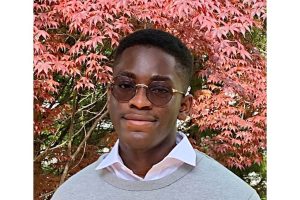
When Dayann D’almeida began his first year at Johns Hopkins University, he already had some impressive research experience under his belt. As a high school student in Greenbelt, Maryland, D’Almedia interned at the Johns Hopkins University Applied Physics Laboratory (APL), where he worked alongside professional engineers on the modular prosthetic limb, the world’s most sophisticated upper-extremity prosthesis.
This unique internship piqued his interest in studying brain-computer interface (BCI) technology, said D’almedia, who is double majoring in computer science and biomedical engineering
During the summer of 2021, he returned to APL as a college intern in the highly-competitive RISE@APL program, which offers promising Johns Hopkins undergraduate and graduate students the opportunity to do paid research under the guidance of an APL staff mentor experienced in their field of study.
“Having access to a premier research laboratory in high school was a transformative experience for me,” said D’almedia. “I got the opportunity to work on algorithms for advanced BCIs, which combines two subjects I’m deeply interested in – computer science and neuroscience.”
BCI systems depend on electrode sensors that record electrical signals in the brain and use those signals to drive external devices, such as a prosthetic limb.
As a RISE@APL intern, D’almedia’s research focused on the use of BCIs for prosthetic embodiment. He worked under the guidance of Luke Osborn, a senior researcher and a Hopkins biomedical engineering alum.
Currently, most prosthetic devices don’t provide tactile or sensory feedback to the user; thus, it can be difficult for amputees to truly “embody” their prosthetic limb and consider it as part of them.
“If you can embody a complex system, the idea of human-machine integration becomes more feasible. Based on this theory, we think that improving embodiment will make prosthetic limbs function and feel more like a natural limb,” said D’almedia.
But is possible to “embody” external objects, such as a prosthetic or robotic limb? His team set out to determine if you can track the brain to embody something foreign. They conducted a series of experiments where a participant with spinal cord injury received sensory simulation to the brain, while watching a robotic hand touch various objects.
By looking at changes in the brain signals, the researchers sought to better understand how the brain responds as we begin to incorporate, or “embody,” new devices and systems during sensory feedback. Based on their results, the team found that providing sensory feedback could help promote embodiment.
The project gave D’almeida the chance to flex his computer science skills; his contributions to the project centered on electrode data analysis and creating visual maps of the brain data. “The project helped me understand how ideas rooted in computer science, like data visualization, could be applied to help elucidate concepts so seemingly removed from software and hardware, like brain activity.”
He added that he appreciated all the extra resources that APL had to offer. “I worked on sub research projects and got to interface with different APL experts. It broadened my view on the engineering field. Computer science offers exciting opportunities to further our understanding of many areas, from neuroscience to climate research,” said D’almedia.
He’s still interning at APL on other BCI- related research while taking a full course load. As he looks ahead to his second year at Johns Hopkins, D’almedia he says he’d be excited to continue at APL, but he’s open to exploring new opportunities in the computer science field.
“I want to branch out to other research areas. I’m really interested in artificial intelligence and I want to learn more about software engineering,” he added.
Outside of his research work, D’almedia is a member of several campus and professional organizations, including the Association for Computing Machinery (ACM), the National Society of Black Engineers (NSBE), HopAI, the JHU French Club, and the Japanese American Student Association (JASA). He enjoys coding, running, and playing the violin in his spare time.